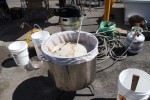Our topic this week is going to focus on the delivery method in which we enjoy our most coveted craft favorites. Misconceptions abound when bringing up whether Draft or Bottle is the preferable choice, allow me to add to the confusion. One also has to take into account that someone just may like one option over the other in many cases. Whichever method you choose, there is a decent argument that can be made for draft, bottles or cans.
Draft – So much of the craft beer industry is personal preference and perception, so often times its easy to get a inordinate amount of misinformation in the process. People are so passionate about what they like that it can sometimes cloud the opinions that are inferred to like minded individuals. As a young lad, I thought draft beer was king and anything else was inferior. Over the course of my craft beer education, I have discovered that this is just not the case in many instances. That is not to say that draft beer is bad by any means, in fact in many situations I much prefer the differing dynamic of a draft beer. I recently had one of my personal favorites, Anderson Valley Gose on tap and it was incredible. All of the salty/funky notes that are perceived in the can were amplified 10 fold in a very complimentary way when I experienced it via draft.
Bottles – Over the past few years I’m sure many of you have stocked refrigerators full of barrel aged stouts, porters and barleywines. There is something to be said about cellaring beer as I have touched on it in a previous post. Being able to collect a few coveted beers, try a few, then proceed to save a few to see how they change is a quite the experience. My point here is that you obviously can not do these things with draft beer. The idea behind draft beer is that it will be consumed fresh in most cases and that the important issues of line maintenance and keeping clean glassware are absolutely paramount to great tasting beer. Most coveted bottles are in brown glass to, for the most part, prevent light struck beer. Also, as long as the caps have been sealed correctly, you have a beer that will remain carbonated for quite a long time. Bottles have quickly become the preferred method of beer geeks everywhere. Much easier to control the conditions and often times for higher ABV beers a much better drinking experience than you would have had on draft.
Cans – One packaging method that would have been laughed at 20 years ago in the craft beer industry is the can. With machinery being produced by several manufacturers now making it much more affordable to can, there are many reasons in today’s craft beer environment to utilize the canning process. Whether or not you believe that the can imparts some flavor to the beer is up for debate. To me, you shouldn’t be cellaring a can anyways. With a can though, you get ultimate freshness and never worry about light entering the beer at any point. You do lose the conditioning capability of a bottle and may not be as ‘fresh’ as draft, but at the end of the day the can is here to stay.
That’s all the time we have this week folks, until next time. Cheers!





